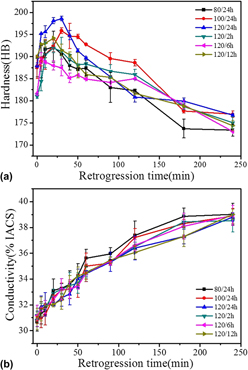Article contents
The effect of pre-ageing on the microstructure and properties of 7050 alloy
Published online by Cambridge University Press: 22 December 2015
Abstract

In the present work, the effect of pre-ageing temperature and time variations on the mechanical properties and electrical conductivity of the Retrogression and re-aging (RRA) treated 7050 has been investigated. The results reveal that the electronic conductivity and hardness of RRA-treated samples are sensitive to the pre-ageing tempers. The RRA-treated samples with 120 °C/2 h pre-ageing +180 °C/2 h retrogression +120 °C/24 h re-ageing temper can be tailored toward a good combination of strength and elongation, while the electrical conductivity of re-ageing samples is also higher than that of 120 °C/24 h pre-ageing RRA-treated samples. With an intermediate pre-ageing temperature of 80 °C/24 h RRA-treated samples possess a higher re-aged electronic conductivity, while no significant differences can be found between hardness of 120 °C/2 h and 120 °C/24 h pre-ageing RRA-treated samples. The variation of hardness and electronic conductivity during retrogression depends on the pre-ageing tempers. For under-aged sample, the retrogression hardness appears a stage of hardness increasing followed by a further decrease in hardness results, owing to disappearance of dissolving stage of fine GP zone and η′ phase during pre-ageing.
Information
- Type
- Articles
- Information
- Copyright
- Copyright © Materials Research Society 2015
Footnotes
Contributing Editor: Yang-T. Cheng
References
REFERENCES
- 7
- Cited by

